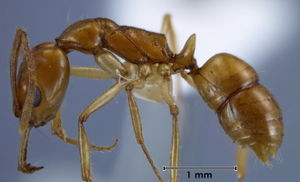Key to Australian Anochetus Species
The following key to Australian Anochetus is based on Shattuck & Slipinska (2012[1]).
1
- Propodeal angles produced as spines => 2
- Propodeal angles more or less rounded and lacking spines => 5
2
- Sculpture on front of head extending only slightly beyond eyes (approximately half head length); eye larger (EL > 0.27mm); scapes surpassing posterolateral corners ('lobes') of head (SI > 100) (Fig. 4); numerous erect hairs on scapes => 3
- Sculpture on front of head extending well beyond eyes (greater than half head length); eye smaller (EL < 0.22mm); scapes not reaching posterolateral corners ('lobes') of head (SI < 100) (Fig. 4); scapes with limited number of erect hairs => 4
3
- Smaller body (HL < 1.62mm, HW < 1.44mm); scapes shorter (SL < 1.50mm) (Fig. 4); sides of propodeum with coarse striations; mesonotum smooth and shining; petiolar node in side view with posterior surface less convex; pubescence on scapes limited, some areas devoid of hairs, the individual hairs only slightly overlapping => Anochetus veronicae
- Body larger (HL > 1.78mm, HW > 1.53mm); scapes longer (SL > 1.60mm) (Fig. 4); sides of propodeum smooth and shining; mesonotum with a few transverse, irregular ridges or striations; petiolar node in side view with anterior surface more convex; pubescence on scapes abundant and covering the entire scape, the individual hairs strongly overlapping => Anochetus alae
4
- Pronotum shining but with shallow, weakly defined oval punctures; propodeal spines directed slightly posteriorly so that in profile they form an angle with the posterior propodeal face at their bases; dorsum of propodeum with appressed hairs; hind tibiae with decumbent hairs which are restricted to the inner surfaces => Anochetus paripungens
- Pronotum smooth and shining; propodeal spines pointed anteriorly and forming a continuous surface with the posterior propodeal face in profile; dorsum of propodeum with erect hairs; hind tibiae with erect hairs on all surfaces => Anochetus wiesiae
5
- Sculpture on front of head extending well above eyes and reaching (or nearly reaching) the posterior margin of head => 6
- Sculpture on front of head extending only slightly beyond eyes and ending well before posterior margin => 7
6
- Sculpturing on dorsal surface of pronotum variable, ranging from punctate medially and striate-rugulose laterally to entirely striate-rugulose, sometimes with arching striations anteriorly (which are developed to varying degrees); mesonotum striaterugulose; sides of propodeum smooth and shining anteriorly, sculptured posteriorly; eyes smaller (EL < 0.16mm) => Anochetus graeffei
- Dorsal surface of pronotum with distinct longitudinal striations (never rugulose); mesonotum smooth, without sculpture; sides of propodeum with coarse striation on entire surface; eyes larger (EL > 0.22mm) => Anochetus victoriae
7
- Petiolar node in front view tapering upwards into a narrowly rounded point => Anochetus isolatus
- Petiolar node in front view narrowing only slightly dorsally, the apex broad => 8
8
- Mesonotum with transverse striations; propodeum with dorsal surface rounding into sides and posterior face, the angle obscured; in side view petiolar node swollen basally and with a strong angle just below mid-height => Anochetus turneri
- Mesonotum smooth and without sculpturing; propodeum with dorsal surface more or less flattened and with distinct propodeal angle; in side view anterior face of petiolar node weakly concave and never angled near mid-height => 9
9
- Entire pronotum and sides of propodeum smooth and shining; dorsal surface of propodeum with weak transverse striations (nearly absent in some specimens); hairs on dorsal surface of propodeum very short, scattered and appressed => 10
- Pronotum partially to completely sculptured; sides of propodeum with coarse striations, dorsal surface coarsely sculptured with combination of irregular rugosity and striations; hairs on dorsal surface of propodeum longer, erect or semi-erect => 12
10
- Eyes small (EL < 0.25mm, EI < 20) (Fig. 7A); scapes shorter (SL < 1.00mm) (Fig. 7B); legs shorter (MTL < 0.80mm, HFL < 1.10mm) (restricted to the northern Kimberley Region) => Anochetus avius
- Eyes large (EL > 0.30mm, EI > 22) (Fig. 7A); scapes longer (SL > 1.05mm) (Fig. 7B); legs longer (MTL > 0.85mm, HFL > 1.18mm) => 11
11
- Propodeum with transverse striations extending slightly laterally onto the sides to at least the level of the spiracle; scapes longer, reaching posterolateral corners ('lobes') of head (SL > 1.40mm); erect hairs on hind tibiae uniformly distributed on all surfaces; eyes expanded laterally so that in full face view they form outer margin of head => Anochetus renatae
- Propodeum with weak transverse striations dorsally which rarely extend onto the sides (when present laterally they are separated from the dorsal sculpturing by a smooth gap); scapes shorter, not reaching posterolateral corners ('lobes') of head (SL < 1.35mm); erect hairs on hind tibia reduced on outer surface compared to inner surface; eyes narrower so that in full face view they do not extend beyond head capsule => Anochetus armstrongi
12
- Petiolar node in side view tapering gradually to apex in the form of an inverted “V”, with the striations fading towards the summit; propodeal angle sharply rounded => Anochetus rectangularis
- Petiolar node in side view narrowing only slightly towards the apex, trapezoid-shaped, with distinct striations along entire height; propodeal angle more gently rounded => 13
13
- Dorsum and sides of pronotum with distinct longitudinal striations; head shorter (HL < 1.04mm); petiolar node narrower (maximum width < 0.28mm) => Anochetus rufostenus
- Dorsum of pronotum smooth and shining, sides with distinct striations; head longer (HL > 1.11mm); petiolar node wider (maximum width > 0.28mm) => Anochetus rufolatus
References
- ↑ Shattuck, S.O. & Slipinska, E. 2012. Revision of the Australian species of the ant genus Anochetus (Hymenoptera Formicidae). Zootaxa 3426, 1–28.



























